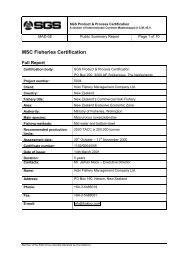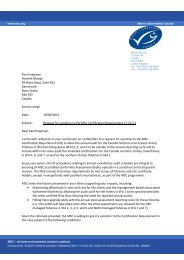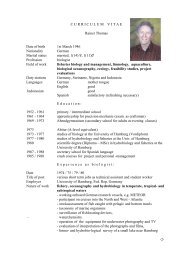SGS Product & Process Certification - Marine Stewardship Council
SGS Product & Process Certification - Marine Stewardship Council
SGS Product & Process Certification - Marine Stewardship Council
You also want an ePaper? Increase the reach of your titles
YUMPU automatically turns print PDFs into web optimized ePapers that Google loves.
a) setting catch levels that will maintain the target population and ecological community‘s high<br />
productivity relative to its potential productivity, and account for the non-target species (or size,<br />
age, sex) captured and landed in association with, or as a consequence of, fishing for target<br />
species;<br />
b) identifying appropriate fishing methods that minimise adverse impacts on habitat, especially<br />
in critical or sensitive zones such as spawning and nursery areas;<br />
c) providing for the recovery and rebuilding of depleted fish populations to specified levels<br />
within specified time frames;<br />
d) mechanisms in place to limit or close fisheries when designated catch limits are reached;<br />
e) establishing no-take zones where appropriate.<br />
11. Contains appropriate procedures for effective compliance, monitoring, control, surveillance<br />
and<br />
enforcement which ensures that established limits to exploitation are not exceeded and<br />
specifies corrective actions to be taken in the event that they are.<br />
B. Operational Criteria<br />
Fishing operations shall:<br />
1. Make use of fishing gear and practices designed to avoid the capture of non-target species<br />
(and non-target size, age, and/or sex of the target species); minimise mortality of this catch<br />
where it cannot be avoided, and reduce discards of what cannot be released alive<br />
2. Implement appropriate fishing methods designed to minimise adverse impacts on habitat,<br />
especially in critical or sensitive zones such as spawning and nursery areas.<br />
3. Not use destructive fishing practices such as fishing with poisons or explosives;<br />
4. Minimise operational waste such as lost fishing gear, oil spills, on-board spoilage of catch<br />
etc.<br />
5. Be conducted in compliance with the fishery management system and all legal and<br />
administrative requirements.<br />
6. Assist and co-operate with management authorities in the collection of catch, discard, and<br />
other information of importance to effective management of the resources and the fishery.<br />
Page 34 of 151





